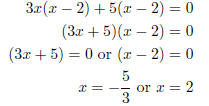Solving Quadratic Equations by Factoring
Questions
1. Solve x2 − x − 20 = 0.
2. Solve x2 + 11x + 18 = 0.
3. Solve 8x2 = 72.
4. Solve (x − 5)(x + 4) = 2(x − 5).
5. Solve 
6. Solve 
7. The area of a rectangular garden is 140 square meters. The width is 3
meters longer than one-half of the length. Find
the length and width of the garden.
8. Jules is standing on a platform 6 meters high and throws a ball straight
up as high as he can at a velocity of 13 meters
per second. At what time t will the ball hit the ground? How far from the ground
is the ball 2 seconds after Jules threw
the ball (assume the ball is 6 meters from the ground when it leaves Jules’
hand).
Solutions
1.
| x2 − x − 20 = 0 |
Find two numbers product is −20 and sum is −1: −5, 4. |
| (x − 5)(x + 4) = 0 |
Use Zero Factor Property. |
| (x − 5) = 0 or (x + 4) = 0 |
Solve each linear equation. |
|
x = 5 or x = −4 |
|
Check:
(5)2 − (5) − 20 = 25 − 25 = 0
(−4)2 − (−4) − 20 = 16 − 16 = 0
2.
| x2 + 11x + 18 = 0 |
Find two numbers product is 18 and sum is 11: 2, 9. |
| (x + 2)(x + 9) = 0 |
|
| (x + 2) = 0 or (x + 9) = 0 |
|
|
x = −2 or x = −9 |
|
Check:
(−2)2 + 11(−2) + 18 = 4 − 22 + 18 = 0
(−9)2 + 11(−9) + 18 = 81 − 99 + 18 = 0
3.
| 8x2 − 72 = 0 |
Factor. |
| 8(x2 − 9) = 0 |
Factor. |
| x2 − 9 = 0 |
Divide by 8. Difference of Squares. |
|
(x + 3)(x − 3) = 0
(x + 3) = 0 or (x − 3) = 0
x = −3 or x = 3 |
|
Check:
8(−3)2 = 8(9) = 72
8(3)2 = 8(9) = 72
Alternate solution, which only works because there was no x term:
| 8x2 = 72 |
|
| x2 = 9 |
|
 |
when taking square root of both sides of equation, one side can be
±. |
|
x = ±3 |
|
4. Start by multiplying everything to get in form ax2 + bx + c = 0.
(x − 5)(x + 4) = 2(x − 5)
x2 − x − 20 = 2x − 10
x2 − x − 20 − 2x + 10 = 0
x2 − 3x − 10 = 0 Find two numbers product is −10 and sum is −3: −5, 2.
(x − 5)(x + 2) = 0
(x − 5) = 0 or (x + 2) = 0
x = 5 or x = −2
Check:
((5) − 5)((5) + 4) − 2((5) − 5) = 0
((−2) − 5)((−2) + 4) − 2((−2) − 5) = −14 + 14 = 0
5. Start by multiplying everything to get in form ax2 + bx + c = 0.

x2 + 5x = 24
x2 + 5x − 24 = 0 Find two numbers product is −24 and sum is 5: 8,−3.
(x + 8)(x − 3) = 0
(x + 8) = 0 or (x − 3) = 0
x = −8 or x = 3
Check:

6. Start by multiplying everything to get in form ax2 + bx + c = 0.
 |
|
 |
Grouping Method: Find two numbers product is −30 and sum is −1: −6,
5. |
 |
Factor by grouping. |
 |
|
Check:

7. Let x be the length (in meters). Then the width is x/2 + 3 meters. Area is
140 m2.
Area = (length)(width)

 write in form ax2 + bx
+ c = 0. write in form ax2 + bx
+ c = 0.

x2 + 6x − 280 = 0 Find two numbers product is 6 and sum is
−280: −14, 20.
(x − 14)(x + 20) = 0
(x − 14) = 0 or (x + 20) = 0
x = 14 or x = −20
Exclude the x = −20 as unphysical (can’t have negative
length). So The length is x = 14 meters. Width is 10 meters.
8. Set h = 6 and v = 13 in our model equation S = −5t2
+ vt + h (see handout).
5t2 + 13t + 6 = 0 Ball hits ground when S = 0. Use
Grouping Method to factor.
−5t2 + 13t + 6 = 0 Find two numbers product is −30 and sum is 13: 15,−2.
−5t2 + 15t − 2t + 6 = 0
−5t(t − 3) − 2(t − 3) = 0
(−5t − 2)(t − 3) = 0
(−5t − 2) = 0 or (t − 3) = 0
t = −2/5 or t = 3
Exclude the t = −5/3 as unphysical, so the ball hits the
ground after 3 seconds.
Two second after throwing the ball, it it S = −5(2)2
+ 13(2) + 6 = −20 + 26 + 6 = 12 meters above the ground.
|